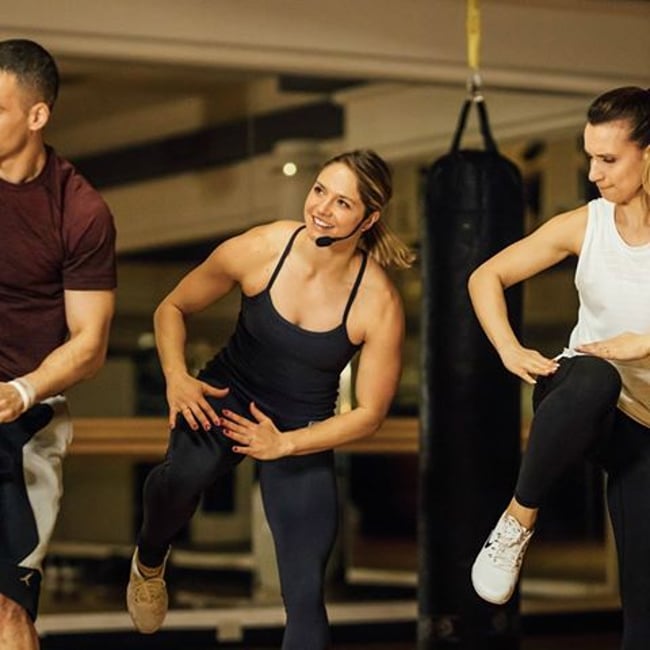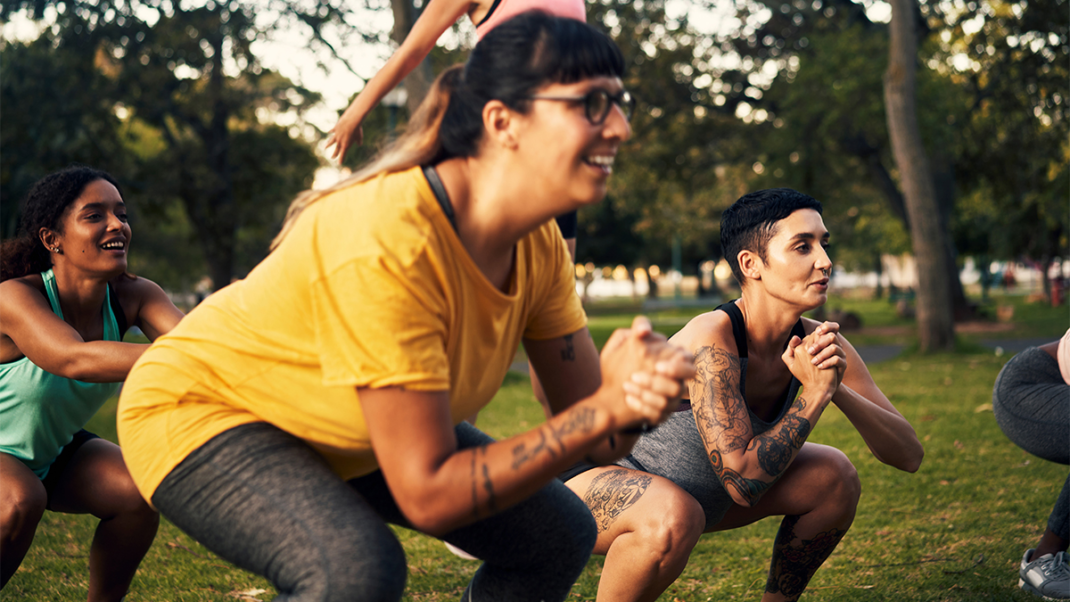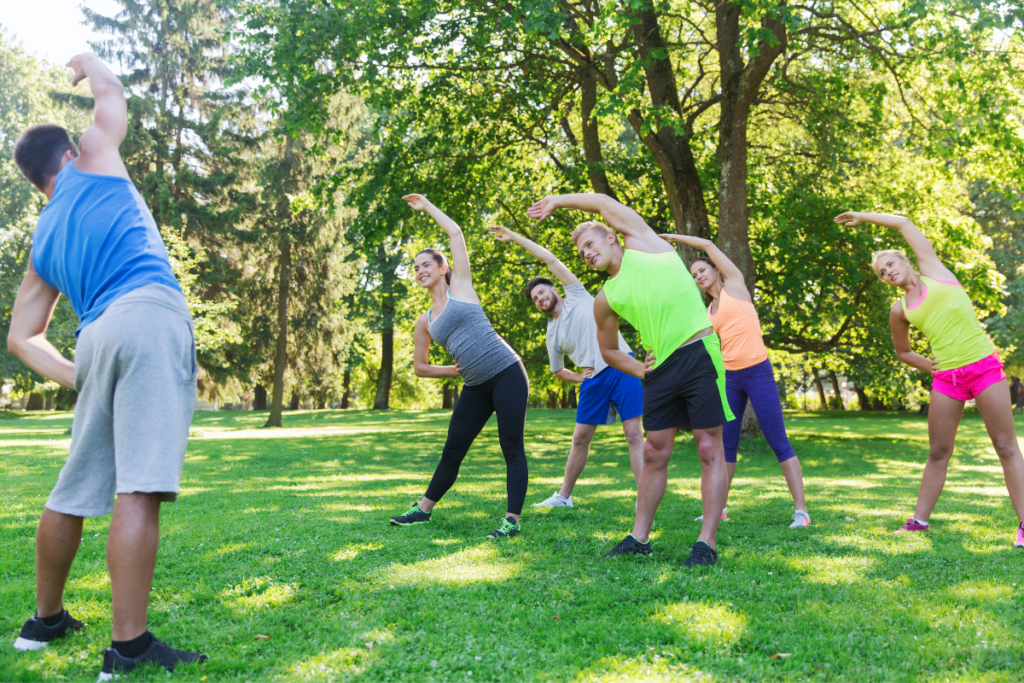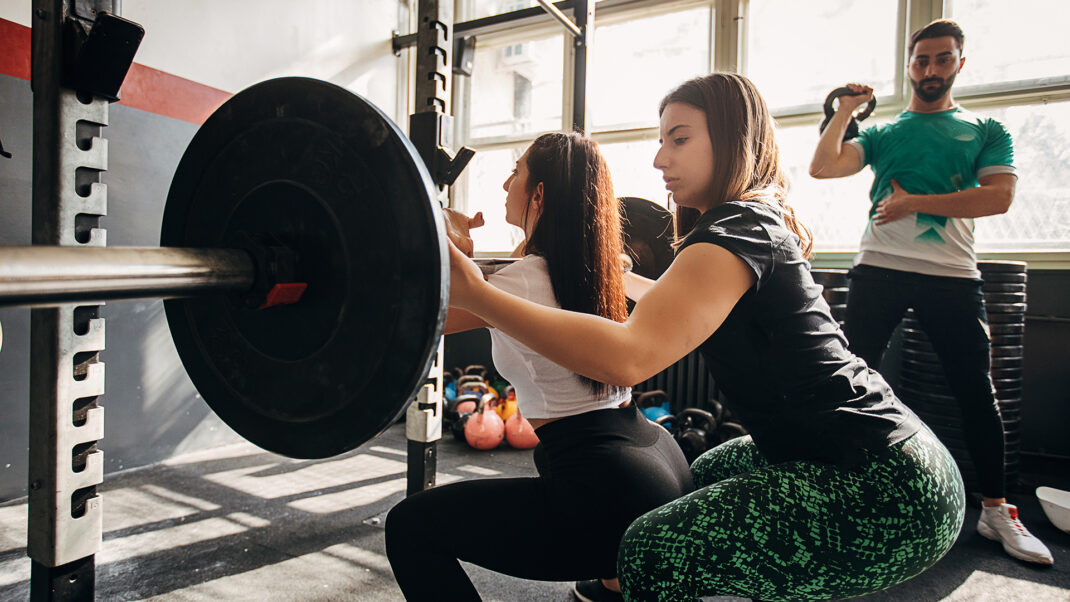Make It Outdoor Group Fitness!
Programming outdoor classes is a perfect chance to let your creativity shine.
Outdoor group fitness participation increased dramatically during the pandemic and is still riding a wave of popularity. Have you noticed all the new outdoor-specific equipment and education companies? Perhaps you’ve already taken advantage of new tools and resources specifically geared for instructors who want to teach outside. Regardless, the outdoor environment can be a bit more complicated than the studio setting. Let’s explore the necessary considerations, planning and programming elements of teaching an outdoor class.
Outdoor Group Fitness Considerations
Teaching outdoors may seem more accessible, open and rules-barred, but it can quickly get complicated. In 2019, Chris Stevenson and Marisa Hoff of The Empower Group, Westlake Village, California, owned Be Military Fit, a U.K. outdoor group fitness class brand. They ran outdoor classes in southern California from their fitness-equipped van until 2021. The pair learned many lessons, and they share their experience here.
Personal Passion
Before reviewing some of the finer points of programming an outdoor group fitness class, it’s important to consider whether it’s something you really want to do. Recognize within yourself (and anyone you hope to hire or work with) that it takes more work and time to teach outdoors. When you’re teaching outside, you don’t have the luxury of easily accessible equipment, a sound system setup and a prepared space. You need to factor in a lot of time for setting up and taking down. You must be willing to show up early, stay afterward and be nimble when things change last minute. Don’t do it if you’re not particularly creative or excited about the outdoor environment.
Scheduling
When it comes to scheduling, most outdoor group fitness classes will be most successful before work, at lunchtime, after work and after school (as with indoor classes). However, the pandemic did make for flexibility in many work schedules, so it may be worth asking participants if they can make it earlier in the day so you don’t end up in the dark when the seasons change. The time of day will also affect your given location. For example, Stevenson shared that they worked in a location with concrete and grass spaces, which appealed to different people during different time frames. “Participants in the early morning preferred the concrete spaces due to the grass being wet with dew, while the classes in the afternoon preferred the grass because it had time to dry out,” he says. (For more about location considerations, see page 64.)
Weather Conditions
The pandemic proved that outdoor classes could be successful year-round in even some of the most unexpected places. While you might think extreme temperatures, wind and rain would prevent participation in colder months, there are plenty of people who are not deterred. In fact, they find community in the misery of discomfort and being in it together! However, those who live in areas that are warmer throughout the year may be less interested in going outside when it’s colder or raining. “In southern California, people would still be wearing gloves and beanies in the 40s,” says Hoff. Everyone’s tolerance level is different, which is why you need to be flexible. Rather than complain about the weather, it’s crucial to find the silver lining for participants to keep their spirits and energy levels up.
Programming

While this may seem obvious, aim to make your outdoor group fitness classes specific to the outdoors. “At this point, we should be making outdoor experiences about the joy of being outside and taking advantage of what an outdoor space has to offer over an indoor space,” says Stevenson. “We aren’t working out outside because we have to; we’re working out outside because we want to, and we’re taking full advantage of the space and freedom it offers.”
Let’s review some outdoor format options, specific outdoor considerations for each, and how you can use the unique elements of the outdoor environment to enhance the experience.
Yoga: Find the flattest location possible. The grass may seem friendly, but bumps and grooves make some poses, especially balancing postures, more challenging. Use cues that highlight the fact that you’re outside. For example: “Reach your hands toward the sky;” “Watch the trees swaying while in your tree pose;” “Take a breath of fresh outdoor air;” or “Feel the sun on your face.” And create a class plan just for the outdoors: You might offer a long warmup and shorter savasana if it’s colder, or teach cooling poses if it’s warmer.
Sports conditioning: Educate participants about the value of being exposed to the elements by training outdoors before the big game or event. Choose a large location with plenty of room to sprint, jump and practice agility. Use cones or painted lines for various challenges and games to bring out the competitive spirit in your outdoor athletes.
Running: Teach an outdoor class specific to runners, such as cross-training or leading a running group. Cross-training involves strengthening supporting muscles, refining alignment and teaching mobility exercises, whereas a running group might include a warmup, intervals or long runs, and a cooldown.
Cycling: Similar to running, an outdoor cycling class is a great cross-training opportunity for strengthening strategic muscle groups and improving movement patterns, or it can simply be for a group of cycling enthusiasts who are seeking community and leadership on proper warmup and cooldown exercises and interval/course ideas. You might also create a class that focuses on cycling-specific recovery, with corrective exercises and stretches that target overworked, tight muscles that spend a lot of time in forward flexion.
Climbing: Climbing has seen a significant spike in popularity due, in part, to the rise of indoor climbing gyms. Cross-training for climbing is an excellent option for an outdoor program, especially if you can incorporate suspension training and playground equipment such as monkey bars to develop core and grip strength.
Boot camp: You have so many creative options to choose from when you teach a boot camp class! In addition to using standard (portable) equipment such as resistance bands, suspension trainers, dumbbells and medicine balls, you can also incorporate stairs or bleachers, benches, pullup bars or rings, fences, painted lines, and more. Have fun!
Dance and kickboxing: While the grass may seem like an ideal place to offer dancing and kickboxing, it can be unpredictable terrain, depending on how freshly cut the grass is, and you never know if or when sprinklers will turn on during class in the early morning or evening hours. When teaching on concrete, remind participants about the increased stress put on the joints, and encourage rest breaks for anyone experiencing discomfort in their hips, knees or ankles.
See also: Making Outdoor Fitness Work
Level the Playing Field in Outdoor Group Fitness
An outdoor environment is an accessible, less-intimidating environment than a gym, which allows more people to discover the joy of consistent movement. “A gym has mirrors and the outside is just the outside,” says Hoff. The outdoor environment can break the monotony of teaching in a gym. Set the expectation for yourself and your participants that there may be a period of “learning as we go.” If done right, outdoor offerings can provide a much-needed option for new and veteran participants . . . and instructors!
Liability, Logistics and Locations
Whether teaching for a facility or on your own, check the following areas to ensure you’re up to date before scheduling your first class.
Liability
- Check your liability insurance policy. Is it up to date? Does it provide coverage for teaching outdoors? If not, update your coverage.
- Make sure your waivers are current. If you’re not sure where to begin, reach out to your insurance provider.
- Obtain the proper permits. If you plan to teach in a public park or on private property, get permission from the parks and recreation department or the property owner.
- Ensure your CPR/AED certifications are up to date.
- Visit the space to see if the lighting is adequate and if you’ll need to ask permission to turn on an additional lighting. Research the crime statistics.
Logistics
“Think through the participant experience from beginning to end,” says Marisa Hoff, who taught outdoor boot camp workouts for several years. She proposes the following questions:
- Where will participants park their cars?
- Where will they put their things (phone, wallet, keys, extra layers of clothing, etc.)?
- How will they sign up for class, and will you track them?
- Will you charge money?
- How will you collect payment?
- How will you communicate changes in location or timing due to weather or other unexpected events?
Note: The answers to these questions largely depend on whether you offer a one-off class or something ongoing. Also, if the weather can be unpredictable in your region, decide if you want a Plan B and how you will communicate updates to participants. One option is to create a group text thread or use WhatsApp or Facebook Messenger so that you can send last-minute notifications if the location changes or if class is canceled.
Location
Deciding on a location for outdoor fitness can become overly complicated very quickly, so start somewhere! When determining your preferred site, the most critical factors to consider are safety, space, access to bathrooms and parking. Here’s a list of possible locations:
- park
- trail
- field
- empty lot
- corporate break areas
- stadium or sports field
- playground
- apartment community center
- pool deck
- beach
During the pandemic, many fitness facilities built designated outdoor spaces, often on the grounds of their indoor facility, which is yet another option. Take inventory of all your options, and compare pros and cons. Ensure there is enough space for the number of participants you anticipate, and visit these areas on the days and times you’re considering, so you can see if other events, landscaping or the sun’s location might affect sound, safety, shade, etc.
Staci Alden
Staci Alden is committed to helping group fitness managers elevate their programs, instructors, and leadership skills through her writing, presentations, and YouTube channel. For more than a decade, she has overseen a team of over 100 private Pilates and group fitness instructors at a luxury health club in Seattle, Washington. Staci also is certified as a master Balanced Body® barre and MOTR® instructor.






